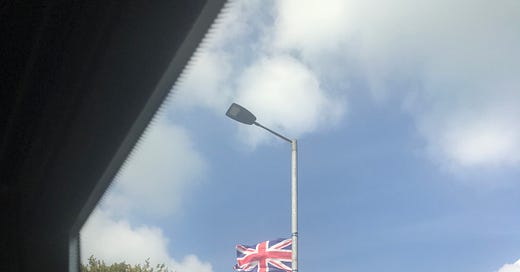On a recent trip to Northern Ireland, to attend the wedding of some friends (which was wonderful) I found myself on a coach. I was travelling, like a politician, up and down the country. Sorry—which country? How many countries? Well, what I meant to say is that I was travelling up and down the island. Surely that can’t be controversial?
The political reality of course was that I was travelling between two countries, divided by a makeshift partition which has now lasted for about a hundred years. Most English people I know of find this a bit odd—it is inherently an unsettled division, pointing awkwardly at unfinished business. Maybe there’s even some cryptoracism in this glib sense of unease—‘real’ countries and respectable dependent regions don’t have adjectives in their names, like equatorial or Central African or Democratic Republic…
Given the Troubles, the partition of the island of Ireland obviously turns out to have been an unsettled division. But border partitions are not the sole creator of divisions out of nowhere: they’re a symptom of divisions that already exist.
The nervous Englishman’s talking point is that a united Ireland will be inevitable because of demographics. I’m not all that interested in whether this is actually true. Rather, I’m interested in the fact that English people on the sidelines (myself included) would prefer to stick to an apparently ‘data driven’ and dispassionate story which has the comforting whiff of certainty. If you talk about a united Ireland as a result of demographics, you’re not passing comment on whether that’s a good thing, a bad thing, or even explicitly saying it’s a neutral thing. You’re making a weather forecast and not passing comment as to the desirability of rain.
I’m afraid I’m going to be just as evasive in this little essay, and I’m not going to pick sides. Yet the notion of picking sides, as opposed to having them picked for you, also betrays the position of an outsider. I’m not even going to pass comment, then. There is no real way of credibly opining on this political history without doing a) a large amount of research; and b) coming from an in-group background, or a sufficiently distant (i.e. not English) out-group background.
I’m not therefore going to try and say things to the players in the Northern Irish sectarian divide. Instead, I’m going to try and understand what they’re saying to each other.
As I said, took a coach up and down the country. I took three journeys, one from Dublin in the Republic, to Derry in Northern Ireland, and the other from Derry to Belfast, and finally from Belfast back to Dublin. Between these places there are shifting landscapes and streetscapes. There are shifting signs—little details of graphic design being altered as you cross the pointedly unpointed markedly unmarked border. The Irish Republic’s half-uncial script for Gaelic names disappears. It’s swallowed up by the standard-issue serif of British motorways. Oh—we’ve crossed the border: past tense. Don’t blink, and you’ll still miss it anyway, because a visible marker of boundaries would be a bombing target, so there aren’t any.
What I will call ‘local enthusiasts’ have taken up the task of demarcating the difference where the states don’t want to. It turns out there are two different groups of local enthusiasts who disagree about where they’re locals of. By the way, the fact that a ‘locus’ can be violently divided against itself is further evidence of the folly of localism.
This is where the flags begin.
Anywhere there’s a street lamp, it becomes a flagpole. The flags are nakedly unofficial, because they’re cable-tied in place. But their consistency and multiplicity gives them a pretence of officialdom. Both sides play with flags in this manner, putting them up as far as their ladders will go, making patterned sequences of flags, flag marches, flag salutes, flag synchronised swimming if you will.
There is also a rich variety of flags to be enjoyed. They range from the heraldic, entrenched in specific points in time (these are especially provocative as we’ll see, mind), to the basic, a Union Jack or an Irish Tricolour. The flags might not all be that meaningful to an outsider, and without a bit of basic background. To any local audience the side, the team from which they come, is absolutely obvious.
Who are these flags flying for? It’s worth working through the possibilities. Maybe the flags are flying for those that flew them. The loyalist/protestants are flying their concoction of Red Hands of Ulster and Union Jacks to remind themselves of the fact they’re in Northern Ireland, to cement their sense of belonging in the British Union. The republican/catholics are flying their (mostly) Irish Tricolours to remind themselves not that they’d quite like to join the rest of Ireland, thank you very much, but more probably that they’re wrongfully divorced from the Irish Republic.
The problem with this interpretation is that it relies on a curious forgetfulness. Any team in a religious, ethnic or identity conflict is, famously, not very good at forgetting. The heaps and heaps of signs and symbols make it impossible to forget. The commemoration of your own side’s wounds (omitting those you have inflicted on the other) is done repeatedly and in all media from sculpture to music. No: I don’t think the sectarian flags’ function is for the in-group, at least not for the most part.
If they’re not principally designed for the in group, then they’ve got to be for the other side. The flags are not displayed for, therefore, they’re aimed at. How do flags inflict damage?
—=Part II of this essay will be released next week.=—






I know you're avoiding the topic, but this is good and relevant!
https://www.thefitzwilliam.com/p/northern-ireland-demography-as-destiny?utm_source=profile&utm_medium=reader2